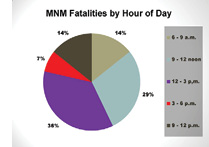This will be the last safety column by Randy Logsdon, as he has accepted appointment by the governor of New Mexico to the position of state mine inspector. We thank him for his contributions to Rock Products. – Ed.
One of the standards for which we measure (or at least expect) safety performance is for personnel to do the right thing when no one is watching. If there is an opportunity for a miner to take a shortcut around safeguards (you name it: lock-out, fall arrest, safe access or any number of critical safety performance standards) with no one noticing it is on the off-shift – when no one is looking.
During the day when management oversight and supervision is on duty, we are more likely to expect employees to follow the rules. Maintenance projects are more carefully planned. Access to tools, parts and advice is more readily available. One does not have to wake up a supervisor or manager to evaluate an unexpected development. Most MSHA inspections occur on day shift. We would expect that if the right thing is done with consistency, it would be during the day shift.
In October, MSHA conducted a stakeholders’ teleconference to prepare operators for the coming month, one that has historically seen the most fatal injuries. In addition to the customary review of fatal and near miss incidents that have occurred year-to-date (YTD), a series of graphs depicting a breakdown of the “relevant” data was presented. One of those caught my attention. There was not a lot of analysis or discussion around this pie chart, and I found that a bit perplexing.
The pie chart depicts the percentage of fatal injuries YTD in five consecutive three-hour time periods during a day. Two facts jumped to my immediate attention. First, 79 percent of the fatal injuries occurred between 6 a.m. and 3 p.m. – the traditional day-shift hours. The remaining 21 percent occurred between 3 p.m. and midnight. Second, no fatal injuries occurred between midnight and 6 a.m.
One major question begs to be answered: Why did an overwhelming number of fatal injuries occur during normal day-shift hours? I was left to speculate. Despite the common sense reasoning advanced above in the second paragraph, it would appear that a fatal injury incident is most likely to occur under what we would consider the most safety conscious hours of the day.
Explanation #1: The data provided on this chart does not account for weekend work where supervision and oversight is also minimized. Other data presented indicated than only 8 percent of the injuries occurred during the weekend (all on Saturday – a regular workday for some operations). We do not know the distribution of that 8 percent between the day shift and the evening shift. We do know that none occurred between midnight and 6 a.m.
Explanation #2: There are fewer miners and therefore there is less exposure during the night shift. In fact some operations only operate during the day. We do not know the actual ratio of day shift to night shift workers in metal/non-metal mining.
So, it’s difficult to reconcile that effect. Regardless, one would expect that there would be some small percentage of the fatal injuries between midnight and 6 a.m. After all, 21 percent of the fatal injuries occurred between 3 p.m. and midnight (although none were reported to have occurred between 6 p.m. and 9 p.m.). This same explanation extends to the fact that more personnel are on duty on the day shift, therefore expanding the exposure during those hours.
Explanation #3: Tasks that involve greater risk are scheduled and performed on the day shift when resources are more available. More mechanical and electrical tasks are performed when personnel qualified to perform those tasks are scheduled to work. Of course this does not account for the lone specialist who is called out of bed at 2 a.m. to troubleshoot an electrical or mechanical breakdown.
So, what are we to do with this information? I will suggest that the data does not prove that the hours of midnight to 6 a.m. are necessarily the safest hours to work. The data reflects only 14 fatal injuries so I would not suggest adjusting your production schedule to nights instead of days. The results reported may actually be an anomaly.
What I will suggest is that superficial data can be very misleading. The time of day or day of the week an injury occurs is simply a data point and is therefore meaningless without understanding the other causal factors and any interaction that these factors had in contributing to the incident. The question to answer in any injury analysis is not “when,” but “why.”

